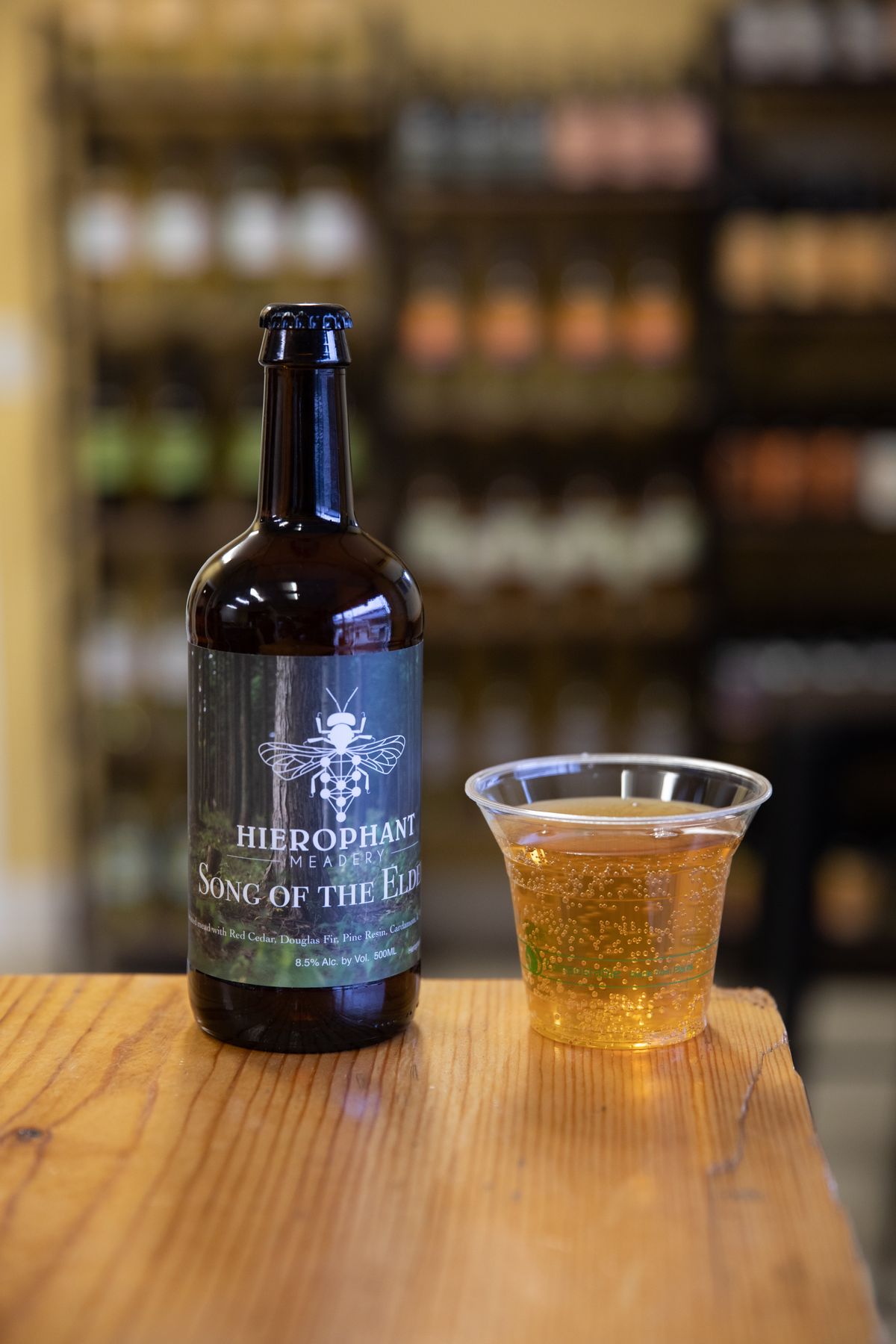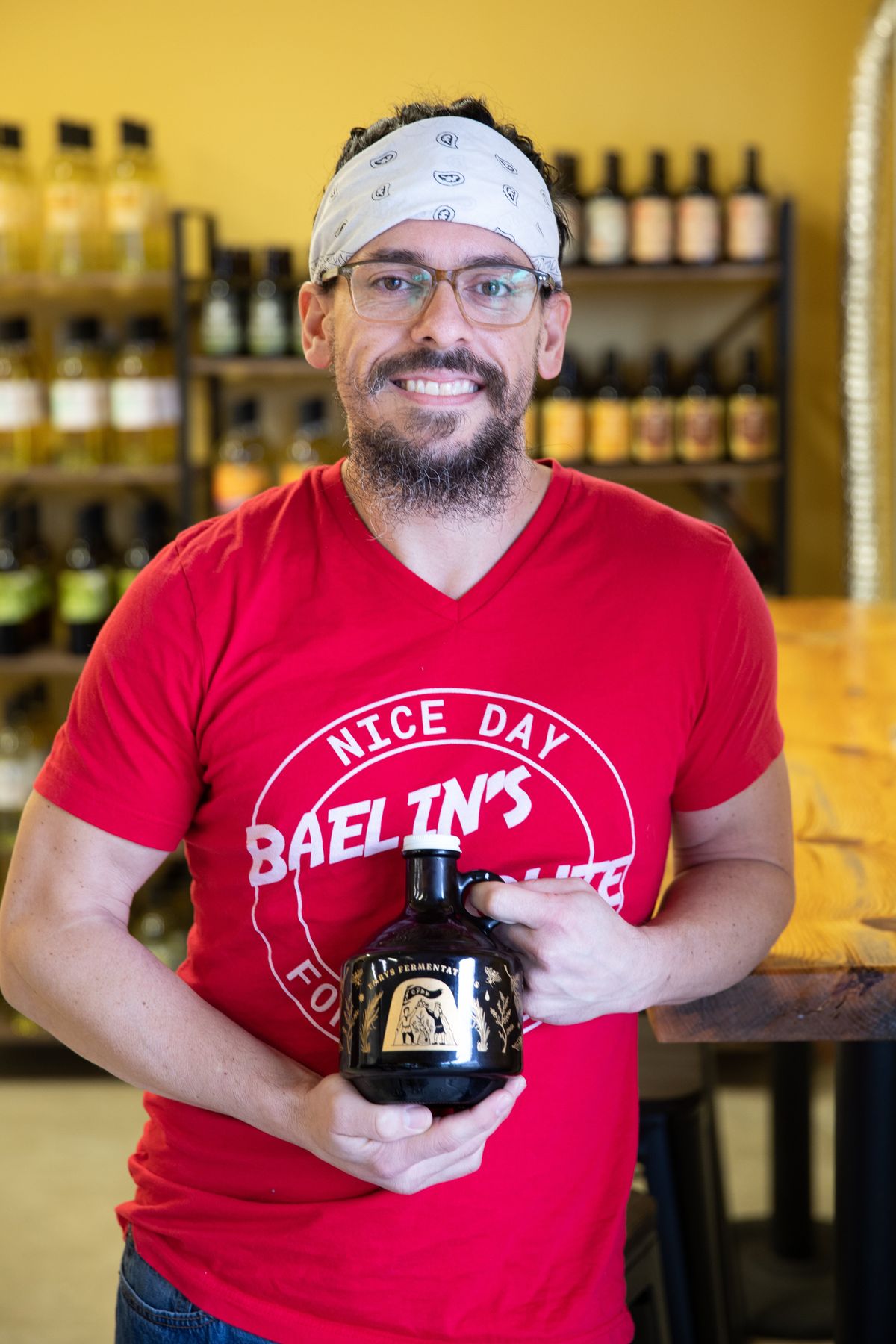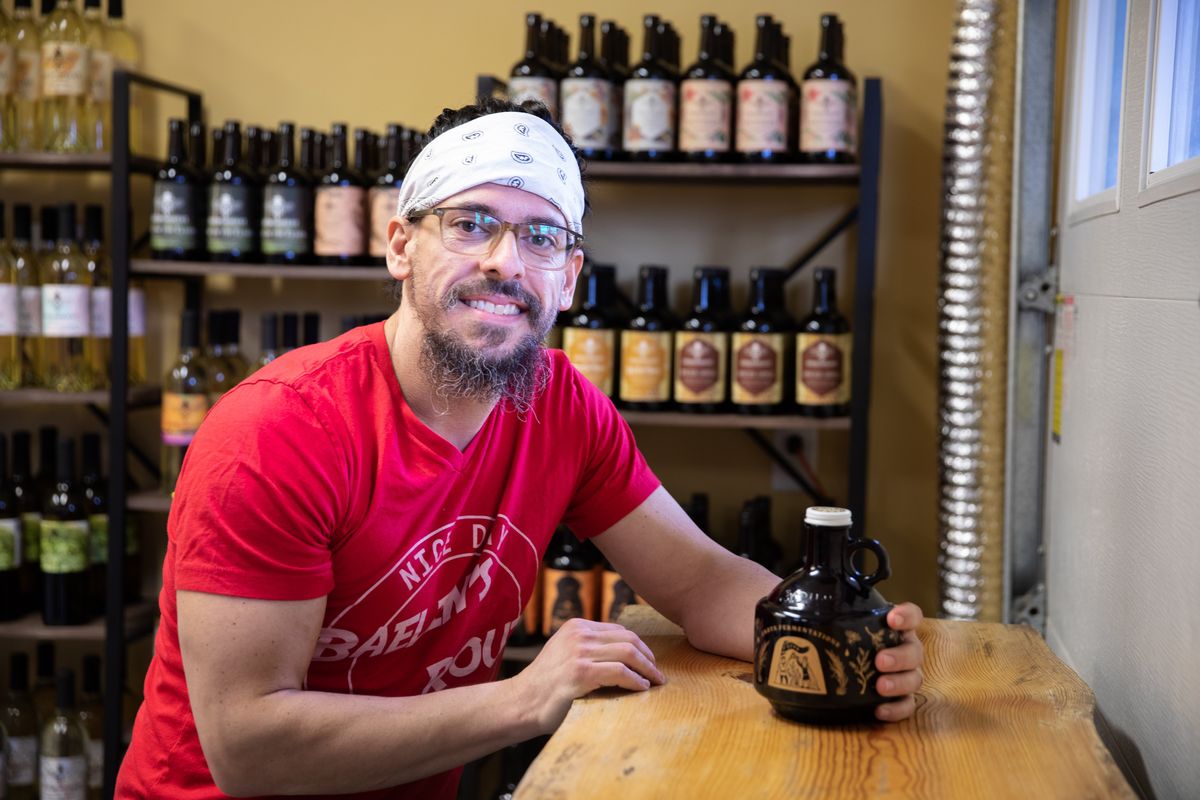A need for mead: Brewer Thomas Croskrey talks ‘fermented honey in water’ ahead of opening Emrys Fermentations
Brewer Thomas Croskrey specializes in making mead, and he is opening the meadery and brewery Emrys Fermentations in Liberty Lake. Croskrey is pictured here at Hierophant Meadery, in Green Bluff, with mead he made at home. (Courtesy of Ari Nordhagen)
Mead by definition is “fermented honey in water,” but the confounding alcoholic beverage is widely known, incorrectly, as honey wine. I had never heard of mead until attending a mead-pairing pop-up dinner at Remedy in January – meaderies are far outnumbered by breweries – but immediately loved the alluring adult concoction.
Brewer Thomas Croskrey, known for opening Bellwether Brewing, his work at Hierophant Meadery in the Green Bluff area in, appropriately, Mead, and helping launch brewing operations at Lone Mountain Farms in Athol, is opening Emrys Fermentations, a meadery and brewery in Liberty Lake. Progress continues through many delays due to supply chain and economic issues, so an opening target date is not currently set.
Croskrey, 40, sat down at Hierophant, 16602 N. Day Mt. Spokane Road, to talk all things mead while Colton McKerrow, aka a Hustla at Hierophant, served flights of mead, and Croskrey even brought homemade mead to share and that he plans to offer at Emrys Fermentations.
For someone who has never heard of mead, how would you describe mead?
The very basics of it, to get started, is that mead is fermented honey in water. That is probably going to spark more questions from people, depending on their baseline knowledge, but that’s where I would start.
How is mead alcoholic, and what is the difference between mead and beer?
The difference between any alcoholic beverage is the sugar source. Wine is traditionally grapes, but it’s fruit in general. With cider, you’re getting apple sugars. Mead is all about fermented honey sugars. Beer is all about fermented malt or grain sugars. So, that’s really the difference between the categories of alcohol.
This doesn’t include distilling because that is a totally different process. One interesting fact is that there are about the same number of meaderies in the entire U.S. as there are breweries in Washington state. It’s a quick, flippant statistic I like to share.
Is Hierophant the only meadery in the area? Colton mentioned that one just opened in the Tri-Cities, and there is one in Missoula.
They’re a really small outfit, but there’s Mystic Mead in the Spokane Valley. They opened maybe around a year ago. They’re so small that they’ve only produced a few barrels so far. I know that they’re working on growing. They just announced growth into bottling, so I’m really excited to see where that takes them. I’m sure their production volumes and market presence will be growing.
You founded and opened Bellwether Brewing and then worked here at Hierophant. What made you want to take Emrys Fermentations as your next step?
My original plan for Bellwether was to make beer and mead when it opened seven years ago. But I found out that mead is regulated as wine, and, at the time, the federal government wouldn’t allow that to coexist under the same roof. You needed to have separate facilities for a winery vs. a brewery.
That changed in 2016, but even after that, we decided that Bellwether was best as it was as a brewery. So, I decided to separate so that I could pursue mead and beer. There are more details, but that’s the general gist of it.
So, when was the seed planted for Emrys Fermentations?
Officially, I would say late 2018, but it’s been delayed with the pandemic, which has turned out to be great because I did have another location picked out in 2019. But then the River District in Liberty Lake became available, which I love partly because I grew up in that area. I grew up in Otis Orchards but rode my bike in the exact area where my building is now.
In 2019, when that became a possibility and then a reality, we jumped at it and were supposed to start building in 2020, and then the shutdowns and lockdowns started. Construction was prohibited for a while, and that started the delays. Now, we’re in 2022, and there is still a lot of unpredictability.
How did your time at Hierophant prepare you to open Emrys Fermentations?
I became more familiar with the mead industry and behind the scenes. You might think that there are a lot of similarities, but wine culture is very different from beer culture. It’s the same with mead. You’re talking about social and legal and regulatory cultures and more.
What innovations have you led in the brewing – beer and mead – industry?
I really like to bridge or hybridize the historic with the modern. There is a lot that informs that and why I take that approach. For one, just because it’s older doesn’t mean it was a bad product. I really have a strong belief that ancient beverages are still tasty. They didn’t all taste like feet and vinegar (laughs).
How would you describe the flavor profile of mead to someone who has never had it?
This is one thing that really fascinates me and draws me to mead. In my opinion, mead is the most versatile fermented beverage. Beer is extremely versatile, but you would virtually never find a still, or uncarbonated, version of it.
But with mead, you can have still mead, carbonated mead, 3% ABV mead, you can have 25% ABV mead. It really runs the entire gamut. With mead, there is so much possibility for playing around with flavor profiles.
That was my next question. How do you choose flavors for mead?
Sometimes, I’ll take a historical, or what I call replica, point-of-view and research a long-standing style and find out whatever I can. There will be other sources of inspiration. I really like Douglas fir trees (laughs). One thing, growing up while I was camping, I would always pick some pine or spruce or fir needles and add them into my coffee or tea.
It depends on if I’m aiming for historic or modern. One thing, when I’m trying to tailor flavor profiles, if I attach it to a style, I follow that style. I don’t want to use a style reference and then obliterate the heck out of it. To me, that’s a breach of communication.
How long have you been a brewer?
Professionally or commercially, since 2014, so right around eight years.
What are some of your favorite flavor profiles that you’ve made?
My runaway favorite profiles are combining our native or indigenous pine trees, and that includes pine, fir, Douglas fir and spruce – I love those – and then matching that with citrus. The pine family and the citrus family just work together so well. They have a lot of things in common. I really love working with those profiles.
What can people expect when Emrys Fermentations opens?
A really strong hybridization of modern with history. For example, if we’re doing an English mild, we’ll adapt it to Pacific Northwest flavor profiles. We’ll be doing a Pacific Northwest malt primarily out of Palouse Heritage Farms. We’re working a lot with them, and we’re pretty much using 100% of our base malt through those guys.
Our opening English mild is going to be infused with our Pacific Northwest flavors of pine. We’ll be foraging out of the forest (laughs). On the mead side, you can expect to see a lot of varietals of honey from the Pacific Northwest. We expect to be using a lot of honey. In our first year, it’s about 20,000 pounds. That’s a lot of honey (laughs).
Any final thoughts, Thomas?
With Emrys Fermentations, there is the nostalgia growing up there, and my parents still live in the same house that we moved into when I was 5 years old. Which is unusual because my dad is retired Navy, and I was born in South Carolina. But once we got there, it was over, which is great.
I really think that having a full neighborhood is going to benefit us instead of being this new meadery isolated in the middle of nowhere. I’m really excited about the full neighborhood aspect of it. I know who some of our new neighbors are supposed to be, and I think that we’ll really help out each other. It is going to be a really cool atmosphere.









